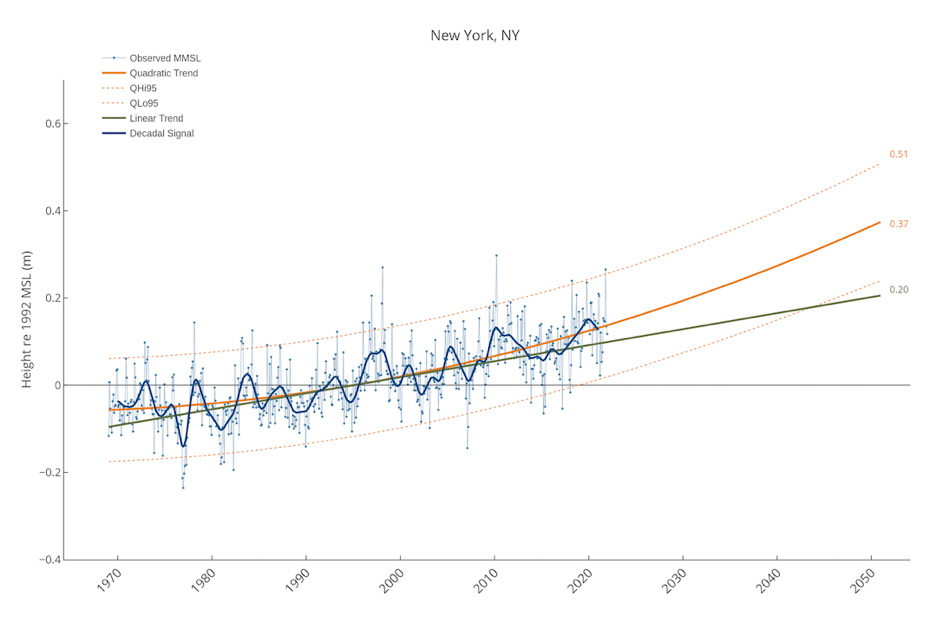Annual sea-level report cards add nuance to latest IPCC assessment
2050 projections offer localized guidance for 32 U.S. coastal localities
William & Mary’s Virginia Institute of Marine Science has issued its annual sea-level “report cards,” which provide U.S. coastal communities from Maine to Alaska with a localized projection of sea-level change to 2050.
The project’s founder, VIMS emeritus professor Dr. John Boon, says “This year’s report cards are especially informative when compared to the global projections issued by the U.N.’s Intergovernmental Panel on Climate Change last August as part of its latest assessment report.”
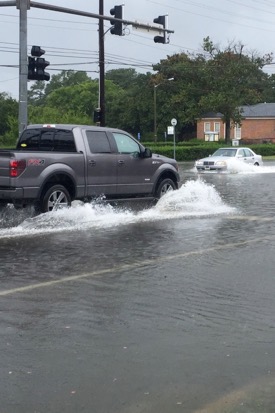
The latest IPCC report—the sixth in a series dating back to 1990—forecasts 7 to 9 additional inches (18-23 cm) of global sea-level rise by 2050, in addition to the 8-inch (20-cm) rise observed during the last century. The IPCC will meet again during the next two weeks to approve its Summary for Policymakers—a distillation of the full August report that governments worldwide rely on to inform efforts for reducing vulnerability to sea-level rise and other global warming impacts.
“Our report cards are in no way a substitute for the IPCC’s global projections,” says Boon, “but they do provide added value to communities, businesses, military installations, and other coastal stakeholders concerned with changes in sea level, as acceleration in sea-level rise varies from place to place.”
The team’s web-based report cards project sea level to the year 2050 based on an ongoing analysis of tide-gauge records for 32 localities along the U.S. coast. The analysis now includes 53 years of water-level observations, from January 1969 through December 2021. The interactive charts are available online at www.vims.edu/sealevelreportcards.
“As in past years,” says VIMS marine scientist Molly Mitchell, “rates of sea-level change in 2021 varied markedly among localities, from a peak rise of 8 millimeters in Grand Isle, Louisiana to a drop of almost 14 millimeters in Juneau, Alaska.” She notes, however, that the tide gauge records from 2021 “were remarkably consistent with data from the previous year, with acceleration in rates of sea-level rise at 27 of our 32 stations.” Mitchell has partnered with Boon to generate the report cards each year since 2017.
Boon and Mitchell say that comparing the IPCC’s global mean projection of sea-level rise to 2050 with VIMS’ localized forecasts offers valuable guidance at the regional and local scale, as rise and acceleration vary with location. “Our projections exceed the global projections in regions like the East and Gulf coasts where acceleration in the rate of sea-level rise is high,” says Boon, “but fall below in regions like the West Coast where acceleration is low. The global projections are much higher than our projections in areas like Alaska where acceleration is negative.” Coastal uplift in Alaska and several localities in the Pacific Northwest causes sea level there to fall relative to the land.
Mitchell stresses that recognition of these regional differences is critical for effective planning at the local level. “Individual localities will experience changes in sea level that differ greatly from the mean global rate,” she says. Examples include Norfolk, Virginia, where the VIMS 2050 forecast is 8 inches (0.21 m) higher than the IPCC’s projected global mean sea-level rise; and Galveston, Texas, with a projected surplus of 12 inches (0.3 m). Indeed, the VIMS 2050 forecasts exceed the IPCC’s global 2050 projection for all 20 localities on the U.S. East and Gulf coasts, from Eastport, Maine (+5 inches) to Port Isabel, Texas (+10 inches). Localities on the U.S. West Coast, on the other hand, are likely to experience sea-level changes that fall below the IPCC’s 2050 projections. Examples include a 7-inch “deficit” in San Francisco and a 4-inch shortfall in Seattle.
The scientists say their forecasts of a sea-level “surplus” for East and Gulf coast communities are of particular concern because they exceed the IPCC’s worst-case projections. “The IPCC issues a range of sea-level forecasts based on possible changes in a suite of socioeconomic factors,” says Boon. These “Shared Socioeconomic Pathways” consider five different scenarios by which the world may evolve during the next century based on changes in population, economic growth, education, urbanization, and the rate of technological development.
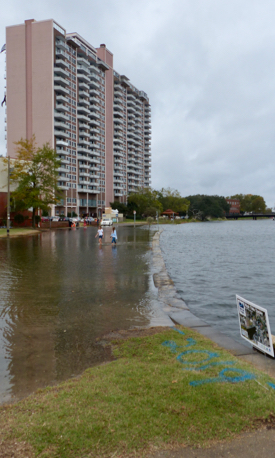
“For certain regions, our report cards forecast significantly higher sea levels in 2050 than the global rates from even the most pessimistic IPCC pathway,” says Boon. Known as SPS 5-8.5, this pathway envisions a future in which humanity continues to rely on fossil fuels, economies expand rapidly worldwide, and greenhouse-gas emissions remain high. This pathway resembles an earlier IPCC scenario known as RCP 8.5, wherein continued high emissions of greenhouse gases result in the trapping of an additional 8.5 watts of heat energy across each square meter of the Earth’s surface.
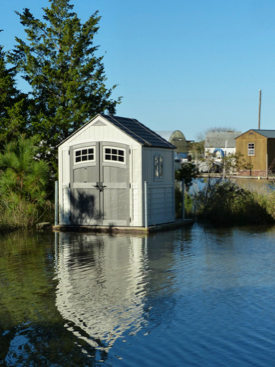
“We have increasing evidence from the tide-gauge records that these higher sea-level curves need to be seriously considered in resilience-planning efforts,” says Mitchell. “Acceleration can be a game changer in terms of impacts and planning, so we really need to pay heed to these patterns,” adds Boon.
In addition to their localized value vis à vis the IPCC's global report, Boon says the report cards add value by providing sea-level projections that are updated more frequently than those issued by NOAA or other agencies. Boon and colleagues also use a statistical approach that includes evidence for the recent acceleration in the rate of sea-level change at many U.S. tide-gauge stations, and stress their use of relative sea-level measurements—changes in water level relative to the land surface on which people live and work. The relative sea-level rise in Virginia and other East and Gulf coast areas is due to both rising water and sinking land.
East Coast Trends
Sea-level rise has now been accelerating at U.S. East Coast stations since 2014. Prior to that year, stations south of Cape Hatteras had recorded little or no acceleration. “Today,” says Boon, “sea level is accelerating faster at many of these southern stations than at some stations further north considered to be sea level rise ‘hot spots’ not long ago.”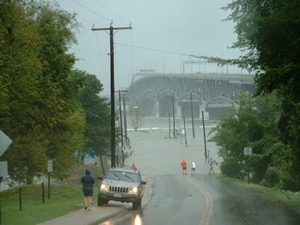
“Rates of sea-level rise in Norfolk, Virginia are still the highest along the Atlantic Coast at 5.4 millimeters per year,” says Mitchell. “However, acceleration at stations in North Carolina, South Carolina, and Georgia indicate that we should be watching sea-level patterns in those states very closely.” Some studies indicate that the “hot spot” of sea-level rise in the mid-Atlantic is moving southward due to melting of the Greenland ice sheet, and that stations south of Cape Hatteras will see greater sea-level rise by 2050 than their histories suggest.
Gulf Coast Trends
Most Gulf Coast stations witnessed an upturn in acceleration rates beginning around 2014, and all nine of them have experienced increased acceleration during the last four years. At Grand Isle, Louisiana and Galveston, Texas, these trends marked a transition from deceleration to acceleration. At others, including Pensacola, Florida and Rockport, Texas, sea level has been accelerating since 2004 but trending faster in recent years.
Texas and Louisiana stations continue to show the highest rates of rise in the country. Rockport has the second highest annual rise rate (7.2 mm/year in 2021), and the highest projected sea-level rise for 2050 at 0.8 meters (2.62 ft) above mean sea level in 1992, the midpoint of the most recent National Tidal Datum Epoch. Grand Isle flips the tables, with the highest annual rise rate (8.1 mm/year in 2021), and the second highest projected sea-level rise for 2050 at 0.58 meters (1.9 ft) above 1992 levels. Galveston places third in both measures, with an annual rise rate of 6.6 mm/year in 2020, and a projected rise in 2050 sea level of 0.57 meters (1.87 ft).
Mitchell and Boon attribute the extreme rise rates and sharp contrast in acceleration among the Gulf Coast stations in part to their location within a sedimentary basin with complex history of water and mineral extraction. Pumping of groundwater and oil can cause land subsidence, which contributes to relative sea-level rise.
West Coast Trends
With the exception of Alaska and Crescent City, California—where plate movements and post-glacial rebound generate pronounced coastal uplift—U.S. West Coast stations had been essentially neutral since at least 2004, with relative sea level neither rising nor falling at significant rates. That is no longer the case, as most stations have experienced acceleration since 2017. “Upward trends in acceleration presage positive and increasing sea-level rise rates at most stations along the continental west coast,” says Boon. “Rise rates had been near zero for some time, but nascent acceleration is beginning to cause them to pop.” Scientists suggest that the speed-up is due to a shift in wind patterns associated with the Pacific Decadal Oscillation, an El Niño-like pattern of climate variability.
Overall Trends
Previous work by Boon, Mitchell, and VIMS colleague Derek Loftis suggests the current acceleration in rates of sea-level rise began around 2013 or 2014, likely associated with ocean dynamics and ice-sheet loss. In 2020, rates of sea-level rise accelerated at all 21 of the report-card stations along the U.S. East and Gulf coasts, and at 7 of the 8 monitored stations along the U.S. West Coast excluding Alaska. All four stations monitored in Alaska show relative sea level falling at increasingly rapid rates. This is due to various processes causing rapid uplift of the coast, tide gauges rising along with the land they rest on.
Visit our report card webpage for full-size, interactive versions of all 32 report cards.

